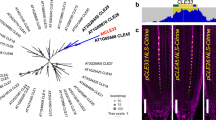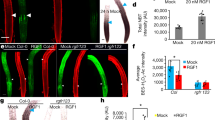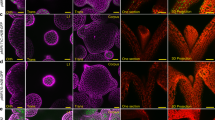Abstract
Plants continuously maintain pools of totipotent stem cells in their apical meristems from which elaborate root and shoot systems are produced. In Arabidopsis thaliana, stem cell fate in the shoot apical meristem is controlled by a regulatory network that includes the CLAVATA (CLV) ligand–receptor system and the homeodomain protein WUSCHEL (WUS)1,2. Phytohormones such as auxin and cytokinin are also important for meristem regulation3. Here we show a mechanistic link between the CLV/WUS network and hormonal control. WUS, a positive regulator of stem cells, directly represses the transcription of several two-component ARABIDOPSIS RESPONSE REGULATOR genes (ARR5, ARR6, ARR7 and ARR15), which act in the negative-feedback loop of cytokinin signalling4,5. These data indicate that ARR genes might negatively influence meristem size and that their repression by WUS might be necessary for proper meristem function. Consistent with this hypothesis is our observation that a mutant ARR7 allele, which mimics the active, phosphorylated form, causes the formation of aberrant shoot apical meristems. Conversely, a loss-of-function mutation in a maize ARR homologue was recently shown to cause enlarged meristems6.
This is a preview of subscription content, access via your institution
Access options
Subscribe to this journal
Receive 51 print issues and online access
$199.00 per year
only $3.90 per issue
Buy this article
- Purchase on Springer Link
- Instant access to full article PDF
Prices may be subject to local taxes which are calculated during checkout




Similar content being viewed by others
References
Schoof, H. et al. The stem cell population of Arabidopsis shoot meristems in maintained by a regulatory loop between the CLAVATA and WUSCHEL genes. Cell 100, 635–644 (2000)
Brand, U., Fletcher, J. C., Hobe, M., Meyerowitz, E. M. & Simon, R. Dependence of stem cell fate in Arabidopsis on a feedback loop regulated by CLV3 activity. Science 289, 617–619 (2000)
Leyser, O. Regulation of shoot branching by auxin. Trends Plant Sci. 8, 541–545 (2003)
Kiba, T. et al. The type-A response regulator, ARR15, acts as a negative regulator in the cytokinin-mediated signal transduction in Arabidopsis thaliana. Plant Cell Physiol. 44, 868–874 (2003)
To, J. P. et al. Type-A Arabidopsis response regulators are partially redundant negative regulators of cytokinin signalling. Plant Cell 16, 658–671 (2004)
Giulini, A., Wang, J. & Jackson, D. Control of phyllotaxy by the cytokinin-inducible response regulator homologue ABPHYL1. Nature 430, 1031–1034 (2004)
Laux, T., Mayer, K. F., Berger, J. & Jurgens, G. The WUSCHEL gene is required for shoot and floral meristem integrity in Arabidopsis. Development 122, 87–96 (1996)
Long, J. A., Moan, E. I., Medford, J. I. & Barton, M. K. A member of the KNOTTED class of homeodomain proteins encoded by the STM gene Arabidopsis. Nature 379, 66–69 (1996)
Clark, S. E., Running, M. P. & Meyerowitz, E. M. CLAVATA1, a regulator of meristem and flower development in Arabidopsis. Development 119, 397–418 (1993)
Clark, S. E., Running, M. P. & Meyerowitz, E. M. CLAVATA3 is a specific regulator of shoot and floral meristem development affecting the same processes a CLAVATA1. Development 121, 2057–2067 (1995)
Kayes, J. M. & Clark, S. E. CLAVATA2, a regulator of meristem and organ development in Arabidopsis. Development 125, 3843–3851 (1998)
Mayer, K. F. X. et al. Role of WUSCHEL in regulating stem cell fate in the Arabidopsis shoot meristem. Cell 95, 805–815 (1998)
Fletcher, J. C., Brand, U., Running, M. P., Simon, R. & Meyerowitz, E. M. Signaling of cell fate decisions by CLAVATA3 in Arabidopsis shoot meristems. Science 283, 1911–1914 (1999)
Rojo, E., Sharma, V. K., Kovaleva, V., Raikhel, N. V. & Fletcher, J. C. CLV3 is localized to the extracellular space, where it activates the Arabidopsis CLAVATA stem cell signalling pathway. Plant Cell 14, 969–977 (2002)
Clark, S. E., Williams, R. W. & Meyerowitz, E. M. The CLAVATA1 gene encodes a putative receptor kinase that controls shoot and floral meristem size in Arabidopsis. Cell 89, 575–585 (1997)
Jeong, S., Trotochaud, A. E. & Clark, S. E. The Arabidopsis CLAVATA2 gene encodes a receptor-like protein required for the stability of the CLAVATA1 receptor-like kinase. Plant Cell 11, 1925–1934 (1999)
Lohmann, J. U. et al. A molecular link between stem cell regulation and floral patterning in Arabidopsis. Cell 105, 793–803 (2001)
Roslan, H. A. et al. Characterization of the ethanol-inducible alc gene-expression system in Arabidopsis thaliana. Plant J. 28, 225–235 (2001)
Lenhard, M., Bohnert, A., Jürgens, G. & Laux, T. Termination of stem cell maintenance in Arabidopsis floral meristems by interactions between WUSCHEL and AGAMOUS. Cell 105, 805–814 (2001)
Lemon, W. J., Liyanarachchi, S. & You, M. A high performance test of differential gene expression for oligonucleotide arrays. Genome Biol. 4, R67 (2003)
D'Agostino, I. B., Deruere, J. & Kieber, J. J. Characterization of the response of the Arabidopsis response regulator gene family to cytokinin. Plant Physiol. 124, 1706–1717 (2000)
D'Agostino, I. B. & Kieber, J. J. Phosphorelay signal transduction: the emerging family of plant response regulators. Trends Biochem. Sci. 24, 452–456 (1999)
Skoog, F. & Miller, C. O. Chemical regulation of growth and organ formation in plant tissues cultured in vitro. Symp. Soc. Exp. Biol. 54, 118–130 (1957)
Hwang, I. & Sheen, J. Two-component circuitry in Arabidopsis cytokinin signal transduction. Nature 413, 383–389 (2001)
Schmid, M. et al. A gene expression map of Arabidopsis thaliana development. Nature Genet. 37, 501–506 (2005)
Brand, U., Grunewald, M., Hobe, M. & Simon, R. Regulation of CLV3 expression by two homeobox genes in Arabidopsis. Plant Physiol. 129, 565–575 (2002)
Lenhard, M., Jurgens, G. & Laux, T. The WUSCHEL and SHOOTMERISTEMLESS genes fulfil complementary roles in Arabidopsis shoot meristem regulation. Development 129, 3195–3206 (2002)
Hass, C. et al. The response regulator 2 mediates ethylene signalling and hormone signal integration in Arabidopsis. EMBO J. 23, 3290–3302 (2004)
Schmid, M. et al. Dissection of floral induction pathways using global expression analysis. Development 130, 6001–6012 (2003)
Wu, Z., Irizarry, R. A., Gentleman, R., Murillo, F. M. & Spencer, F. A. A model based background adjustment for oligonucleotide expression arrays. Working Paper 1 (Dept of Biostatistics Working Papers, Johns Hopkins Univ., Baltimore, Maryland, 2004).
Acknowledgements
We thank A. Greenland for providing the AlcA system, J. Palatnik for sharing unpublished results, R. Schwab for establishing the in situ protocol, R. Chen for preparing the WUS antiserum, K. Harter and D. Weigel for discussion, and K. Bomblies, I. Lohmann, M. Schmid, J. Palatnik and D. Weigel for reading the manuscript critically. This work was supported by a Career Development Award of the International Human Frontier Science Program (HFSP) Organization (J.U.L.), a Ph.D. fellowship of the Cusanuswerk (W.B.), grants from the NSF and the NIH (J.J.K.) and the Max Planck Society (J.U.L).Author Contributions A.L. performed in situ hybridizations and qRT–PCRs, constructed reporter genes, the mutated alleles of ARR7 and performed electron microscopy; J.P.C.T. and J.J.K. generated and analysed the arr double and septuple mutants; W.B. performed the ChIP experiments; S.S. generated constructs and transgenic lines of ARR genes; A.K. generated AlcA::CLV3 plants; M.D. performed qRT–PCRs; and J.U.L. carried out the microarray experiment and analysis, performed gel-shifts and wrote the paper. All authors discussed the results and commented on the manuscript.
Author information
Authors and Affiliations
Corresponding author
Ethics declarations
Competing interests
Microarray data have been deposited at ArrayExpress (http://www.ebi.ac.uk/arrayexpress/) under accession number E-MEXP-432. Reprints and permissions information is available at npg.nature.com/reprintsandpermissions. The authors declare no competing financial interests.
Supplementary information
Supplementary Figure 1
Expression patterns of ARR7 RNA. (PDF 105 kb)
Supplementary Figure 2
Activity of ARR5, ARR6, ARR7 and ARR15 GUS reporter genes. (PDF 65 kb)
Supplementary Figure 3
Direct interaction of WUS with regulatory sequences of ARR7. (PDF 81 kb)
Supplementary Table 1
Genes responsive to WUS induction. (PDF 57 kb)
Supplementary Table 2
Oligonucleotides used in Leibfried et al. (PDF 60 kb)
Supplementary Methods
Additional information on mutants and ChIP. (PDF 68 kb)
Rights and permissions
About this article
Cite this article
Leibfried, A., To, J., Busch, W. et al. WUSCHEL controls meristem function by direct regulation of cytokinin-inducible response regulators. Nature 438, 1172–1175 (2005). https://doi.org/10.1038/nature04270
Received:
Accepted:
Issue Date:
DOI: https://doi.org/10.1038/nature04270
This article is cited by
-
Antioxidant system was triggered to alleviate salinity stress by cytokinin oxidase/dehydrogenase gene GhCKX6b-Dt in cotton
Environmental Sciences Europe (2023)
-
Characterization and expression profiles of WUSCHEL-related homeobox (WOX) gene family in cultivated alfalfa (Medicago sativa L.)
BMC Plant Biology (2023)
-
Delivered complementation in planta (DCIP) enables measurement of peptide-mediated protein delivery efficiency in plants
Communications Biology (2023)
-
Novel insights into maize (Zea mays) development and organogenesis for agricultural optimization
Planta (2023)
-
Promoting genotype-independent plant transformation by manipulating developmental regulatory genes and/or using nanoparticles
Plant Cell Reports (2023)
Comments
By submitting a comment you agree to abide by our Terms and Community Guidelines. If you find something abusive or that does not comply with our terms or guidelines please flag it as inappropriate.



